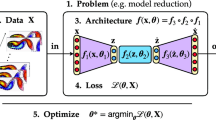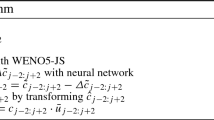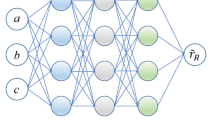Abstract
In this work we study several learning strategies for fluid sloshing problems based on data. In essence, a reduced-order model of the dynamics of the free surface motion of the fluid is developed under rigorous thermodynamics settings. This model is extracted from data by exploring several strategies. First, a linear one, based on the employ of Proper Orthogonal Decomposition techniques is analyzed. Second, a strategy based on the employ of Locally Linear Embedding is studied. Finally, Topological Data Analysis is employed to the same end. All the three distinct possibilities rely on a numerical integration scheme to advance the dynamics in time. This thermodynamically consistent integrator is developed on the basis of the General Equation for Non-Equilibrium Reversible–Irreversible Coupling, GENERIC [M. Grmela and H.C Oettinger (1997). Phys. Rev. E. 56 (6): 6620–6632], framework so as to guarantee the satisfaction of first principles (particularly, the laws of thermodynamics). We show how the resulting method employs a few degrees of freedom, while it allows for a realistic reconstruction of the fluid dynamics of sloshing processes under severe real-time constraints. The proposed method is shown to run faster than real time in a standard laptop.











Similar content being viewed by others
References
Alla A, Kutz JN (2017) Nonlinear model order reduction via dynamic mode decomposition. SIAM J Sci Comput 39(5):B778–B796
Bender J, Koschier D (2015) Divergence-free smoothed particle hydrodynamics. In: Proceedings of the 14th ACM SIGGRAPH/eurographics symposium on computer animation, ACM. pp 147–155
Bessa MA, Bostanabad R, Liu Z, Hu A, Apley DW, Brinson C, Chen W, Liu WK (2017) A framework for data-driven analysis of materials under uncertainty: countering the curse of dimensionality. Comput Methods Appl Mech Eng 320:633–667
Breiman L (2001) Random forests. Mach Learn 45(1):5–32
Brunton SL, Proctor JL, Kutz JN (2016) Discovering governing equations from data by sparse identification of nonlinear dynamical systems. Proc Natl Acad Sci 113:3932–3937
Carlsson G, Ishkhanov T, de Silva V, Zomorodian A (2008) On the local behavior of spaces of natural images. Int J Comput Vis 76(1):1–12
Epstein M (2010) The geometrical language of continuum mechanics. Cambridge University Press, Cambridge
Español P (2004) Statistical mechanics of coarse-graining. Springer, Berlin, pp 69–115
Gingold R, Monahan JJ (1977) Smoothed particle hydrodynamics: theory and applications to non-spherical stars. Mon Not R Astron Soc 181:375–389
González D, Chinesta F, Cueto E (2018) Thermodynamically consistent data-driven computational mechanics. Contin Mech Thermodyn. https://doi.org/10.1007/s00161-018-0677-z
González D, Chinesta F, Cueto E (2019) Learning corrections for hyperelastic models from data. Front Mater 6:14
Gremela M, Oettinger HC (1997) Dynamics and thermodynamics of complex fluids. I. Development of a general formalism. Phys Rev E 56:6620–6632
Huerta A, Liu WK (1988) Viscous flow with large free surface motion. Comput Methods Appl Mech Eng 69(3):277–324
Ibañez R, Abisset-Chavanne E, Gonzalez D, Duval JL, Cueto E, Chinesta F (2018) Hybrid constitutive modeling: Data-driven learning of corrections to plasticity models. Int J Mater Form
Ibanez R, Abisset-Chavanne E, Aguado JV, Gonzalez D, Cueto E, Chinesta F (2018) A manifold learning approach to data-driven computational elasticity and inelasticity. Arch Comput Methods Eng 25(1):47–57
Ibáñez R, Abisset-Chavanne E, Ammar A, González D, Cueto E, Huerta A, Duval JL, Chinesta F (2018) A multidimensional data-driven sparse identification technique: the sparse proper generalized decomposition. Complexity 2018:5608286. https://doi.org/10.1155/2018/5608286
Ibañez R, Borzacchiello D, Aguado JV, Abisset-Chavanne E, Cueto E, Ladeveze P, Chinesta F (2017) Data-driven non-linear elasticity: constitutive manifold construction and problem discretization. Comput Mech 60(5):813–826
Kaiser E, Nathan KJ, Brunton SL (2018) Discovering conservation laws from data for control. arXiv preprint arXiv:1811.00961
Kevrekidis Y, Samaey G (2010) Equation-free modeling. Scholarpedia 5(9):4847
Kim B, Azevedo VC, Thuerey N, Kim T, Gross MH, Solenthaler B (2018) Deep fluids: a generative network for parameterized fluid simulations. CoRR. arxiv:abs/1806.02071
Kirchdoerfer T, Ortiz M (2016) Data-driven computational mechanics. Comput Methods Appl Mech Eng 304:81–101
Kutz JN, Brunton SL, Brunton BW, Proctor JL (2016) Dynamic mode decomposition: data-driven modeling of complex systems. SIAM
L’ubor L, SoHyeon J, Barbara S, Marc P, Markus G (2015) Data-driven fluid simulations using regression forests. ACM Trans Gr 34(6):199:1–199:9
Lam RR, Horesh L, Avron H, Willcox KE (2017) Should you derive, or let the data drive? an optimization framework for hybrid first-principles data-driven modeling. arXiv preprint arXiv:1711.04374
Ly HV, Tran HT (2001) Modeling and control of physical processes using proper orthogonal decomposition. Math Comput Model 33(1–3):223–236
Millán D, Arroyo M (2013) Nonlinear manifold learning for model reduction in finite elastodynamics. Comput Methods Appl Mech Eng 261–262:118–131
Müller M, Charypar D (2003) Gross Markus particle-based fluid simulation for interactive applications. In: Proceedings of the 2003 ACM SIGGRAPH/eurographics symposium on computer animation, SCA ’03, Aire-la-Ville, Switzerland, Switzerland. Eurographics Association, pp 154–159
Munch E (2017) A user’s guide to topological data analysis. J Learn Anal 4(2):47–61
Öttinger HC (2005) Beyond equilibrium thermodynamics. Wiley, Hoboken
Pavelka M, Klika V, Grmela M (2018) Multiscale thermodynamics. De Gruyter, Berlin
Peherstorfer B, Willcox K (2016) Data-driven operator inference for nonintrusive projection-based model reduction. Comput Methods Appl Mech Eng 306:196–215
Proctor JL, Brunton SL, Nathan Kutz J (2016) Dynamic mode decomposition with control. SIAM J Appl Dyn Syst 15(1):142–161
Proctor JL, Brunton SL, Nathan Kutz J (2018) Generalizing koopman theory to allow for inputs and control. SIAM J Appl Dyn Syst 17(1):909–930
Romero I (2009) Thermodynamically consistent time-stepping algorithms for non-linear thermomechanical systems. Int J Numer Methods Eng 79(6):706–732
Romero I (2010) Algorithms for coupled problems that preserve symmetries and the laws of thermodynamics: Part i: Monolithic integrators and their application to finite strain thermoelasticity. Comput Methods Appl Mech Eng 199(25–28):1841–1858
Romero I (2013) A characterization of conserved quantities in non-equilibrium thermodynamics. Entropy 15(12):5580–5596
Roweis ST, Saul LK (2000) Nonlinear dimensionality reduction by locally linear embedding. Science 290(5500):2323–2326
Schenck C, Fox D (2017) Reasoning about liquids via closed-loop simulation. arXiv preprint arXiv:1703.01656
Schenck C, Fox D (2018) Perceiving and reasoning about liquids using fully convolutional networks. Int J Robot Res 37(4–5):452–471
Schenck C, Fox D (2018) Spnets: differentiable fluid dynamics for deep neural networks. arXiv preprint arXiv:1806.06094
Vázquez-Quesada A, Ellero M, Español P (2009) Consistent scaling of thermal fluctuations in smoothed dissipative particle dynamics. J Chem Phys 130(3):034901
Wasserman L (2018) Topological data analysis. Ann Rev Stat Appl 5(1):501–532
Williams CKI (1998) Prediction with Gaussian processes: from linear regression to linear prediction and beyond. Springer, Dordrecht, pp 599–621
Acknowledgements
This work has been supported by the Regional Government of Aragon and the European Social Fund, research group T24 17R. The support given by the ESI Group to F. Ch. through the Chair at ENSAM ParisTech, as well as the funding provided to E.C., D.G. and I.A. through the project “Simulated Reality: An intelligence augmentation system based on Hybrid Twins and Augmented Reality” is gratefully acknowledged.
Author information
Authors and Affiliations
Corresponding author
Additional information
Publisher's Note
Springer Nature remains neutral with regard to jurisdictional claims in published maps and institutional affiliations.
Rights and permissions
About this article
Cite this article
Moya, B., Gonzalez, D., Alfaro, I. et al. Learning slosh dynamics by means of data. Comput Mech 64, 511–523 (2019). https://doi.org/10.1007/s00466-019-01705-3
Received:
Accepted:
Published:
Issue Date:
DOI: https://doi.org/10.1007/s00466-019-01705-3




